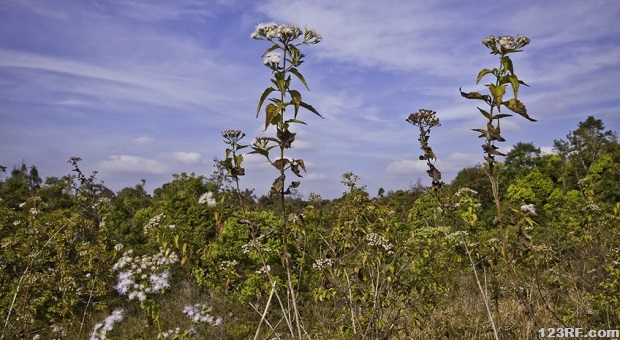If you aren’t going to use hydroponics or indoor gardening methods to provide your food to survive crisis, then you will need to set aside a good bit of land for growing crops.
Unfortunately, large tracts of land organized into vegetable gardens or larger crop fields are easily visible by land and air. But you can use these seven methods to disguise your crops and deter human and animal scavengers as much as possible.
1. Mix Crops with Usable Flowers
When people are looking for food, they don’t often think of flowers as being edible. Therefore, you can disguise vegetable gardens easily among wild flowers or ones that have useful features.
This includes:
- Climbing roses left to ramble on the ground for a thorn cover,
- Marigolds because they tend to inhibit harmful insects,
- Ragweed and goldenrod to deter people with allergies to their pollen.
2. Surround Crops with Natural Trespass Deterrents
Even though certain flowers may deter some people and animals, others need a bit more encouragement to stay away from fruits and vegetables hidden on your property. Burrs, large, spiny cactus, nettles, thorn apple, poison ivy, poison oak, and other noxious plants can be planted in the same area as fruits and vegetables.
If you are going to use poison ivy or other plants that secrete noxious oils, make sure that you can safely remove the oils from any edibles that may have become contaminated.
Needless to say, you can also leave these areas around outer perimeters so that would-be thieves wind up with a few extra problems and won’t look to other areas further in that aren’t covered using noxious plants.
3. Planting in Wooded Areas
If you are fortunate enough to live near a woods, or have wooded areas on your property, these areas make the perfect place to hide a garden. You should choose areas surrounded by heavy undergrowth for plants such as tomatoes and other tall plants that can compete with the wild plants.
Trees that have little vegetation around them can serve as areas where you plant crops in a circular pattern. Typically, you would place tall plants closest to the tree, then mid-range plants and finally an outer layer of thorny bushes.
It is also important to take note of the drip line for each tree. Since water from daffodils is noxious to deer and other wild animals, they will not go near an area where they see daffodils growing under a tree.
In a similar way, you can ring trees with onions to prevent mice from gnawing on the tree trunk. A final outer layer of peppermint and marigolds will also help deter rodents, insects, and other animals that do not like their scent.
4. Reduce Traffic to Growing Areas

In order to reduce the chance of your crops being detected you should:
- Use as many perennial plants as possible
- Avoid using plants that require weeding, mulching and watering
- Harvest crops at night or when you are certain others won’t see you gathering food
5. Use Natural Growing Patterns Instead of Rows
Consider a situation where you normally set 12 tomato plants in a row of your garden. Instead of doing that, place each one in a different part of your yard.
The easiest way to disguise your garden is to do away with row based planting. You can plant in just about any spot, even if it is the middle of a patch of weeds.
6. Focus on Native Perennials
In a time of crisis, some people will be comfortable with eating weeds while others will still ignore their nutritional value. If you are aware of edible plants in your local area that most would not think about, you can focus on those for using as native perennials for your garden. It may also help to include well known ones such as dandelion on outer perimeters.
Depending on the situation, if the looter has enough dandelion to eat, they may not probe further into the yard to find crops of greater value. You can also set up other plants as “sacrifice” to protect others.
7. Disguising Semi-Aquatic Plants
Aside from rice, there are other semi-aquatic plants that will be very important to keep on hand. You can disguise these gardens using poison sumac, vines, and other plants that will make it harder to get to them.
Depending on the area, you may also want to build mats with soil on top for growing land based crops in the middle of a swamp, marsh, or even a running body of water. Just make sure that it will be difficult for looters to get into the water and gain access to the mats.
It is also very important to be aware that larger mats will be visible to satellites, drones, and anything else flying overhead.
There are few things worse than planting a survival garden and then have it looted by animals or humans when the crops are ready. If you can’t afford complex alarm or security systems, then you will be best served by camouflaging edible plants during the growth process.
These seven methods can be used alone or in combination with other ideas to create a secret garden that will provide a reliable source of food for decades with relatively small amounts of effort.
This article has been written bu Carmela Tyrel for Survivopedia.










Rick 173 | September 13, 2014
|
Carmella,
I want to pass on a short story your article reminded of. Over forty years ago before I left New Jersey for the warmer winters of Texas, I used to cut firewood to sell on my property. I had a neighbor who lived a mile down the road, who used to stop and help himself to a few pieces at night after dark.
We got into a stand of Sumac trees that were active and decided to solve my neighbor problem. We split about fifty pieces and seeded the stacks nearest the road. There was on more visit after that and then never again. The smoke carries the oil and contaminates all it touches!
Great Grey | September 13, 2014
|
Goldenrod pollen is not the cause hay-fever. Goldenrod is insect pollinated and its pollen does not become airborne. Ragweed is wind pollinated. Goldenrod get blamed because it blooms at the same time as ragweed, and the flowers are easy to see but the ragweed flowers are not noticed. Now that doesn’t mean somebody getting into a patch of goldenrod won’t have an allergy reaction but don’t count on it. However it is a good buff for those who don’t know better.
radarphos | October 5, 2014
|
I live in a long-frozen winter state. This year I bought Sprout Seeds (about 22 lbs) for my/+family winter/survival “indoor” garden. Some of the sprouts will be edible in 1-2 days, others require more time, like 5-7 days. Some sprouts will produce 1 cup of Sprouts per heaping tablespoon of sprout seed. One type of sprout seed (its size) permits 48 level Tablespoons per pound bag. So I estimated (at a heaping tablespoon size) that I would get a month supply of “a daily cup” of high nutrition vegetable from just a 1 lb bag (at about $10.00/bag). Broccoli sprouts are about 5x more nutritious than adult broccoli crops. Sprouts are high in vitamins and good enzymes. I have a garden too, but its a lot of work and takes “forever” in wait time for harvest. Sprouts (jars or plastic cup, and with screen tops or nylons) requires only filtered water (preferably not tap water because of the bleach in it, etc.), grows a cup of food in a few days (generally requiring a 70 degree temp and indirect light–not in direct sun). They are transportable, can grow into regular garden plants. To me it is the ONLY good solution (per least expense, “work time” and portability) to fresh vegetables any time of year in a survival situation. There is a “juicer” person on YouTube that lived 2 months on just green juice made with a juicer machine. He liked it–it grew on him (though he had a few days of loose stools shortly after he began). A person can survive on sprouts, if you have enough seed, but you probably need to grow more than 1 cup per day.
Pingback:7 Ways to Hide Your Survival Garden | TheSurvivalPlaceBlog | September 15, 2014
|
Pingback:7 Ways To Hide Your Survival Garden | October 28, 2014
|
Pingback:7 Ways To Hide Your Survival Garden - SHTF & Prepping Central | January 19, 2015
|
Pingback:7 Ways To Hide Your Survival Garden | Info You Should Know | February 8, 2015
|
Pingback:Survival Secrets From Your Garden: How to Use Roses | Prepper's Survival Homestead | May 15, 2016
|